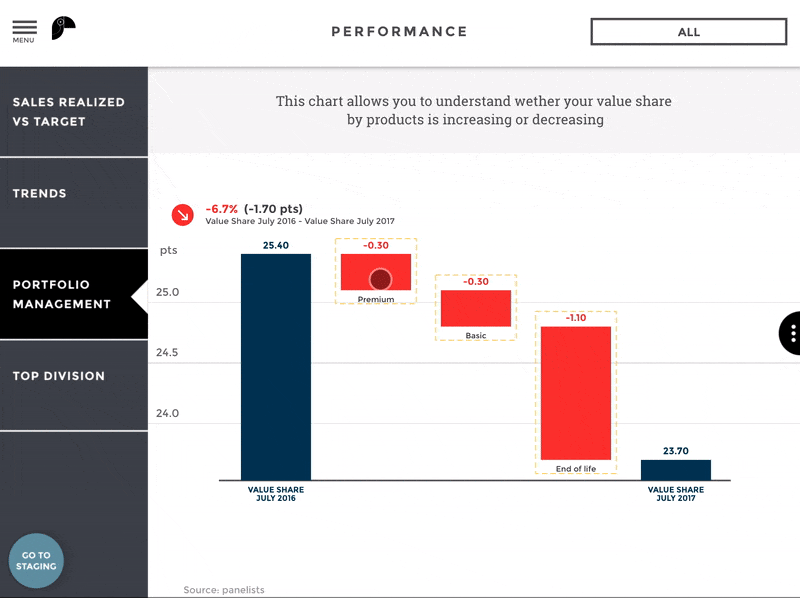Product managers (PDMs) rely on key performance indicators (KPIs) to make decisions. They evaluate the overall revenue, the progress of the product, and the health of the business. Specific KPIs for product managers include those related to the revenue generated, customers, and the overall process of bringing a product to market.
KPIs should be used to identify risk and celebrate success. In contrast, the lack of KPIs leaves a product manager blind to what's going on and shows a weakness in their management style. It is important for product managers to determine which product management metrics should be tracked and reported. Let us dive deeper by looking into the life of Peter.

Peter is a project manager at a SaaS company where he is in charge of analyzing existing product features, finding areas of improvement, and building out the features. During his initial analyses for Q3, he finds out that Average Revenue per User (ARPU) is down by 15% compared to Q1. This is indeed a concerning drop. Lower ARPU indicates that current users are seeing lesser value in the product, this is further supplemented by lower adoption rates across user organizations. Going tough the customer satisfaction reports Peter understands that one of the major reasons for the reduced usage of their application was the lack of analytics. This meant that users had to leave the application frequently to review data and gain actionable insights.
Peter decides to combat this problem by building an analytics section for their application in-house. With a team of developers, testers, and analysts Peter plans a 3-month product roadmap. He puts multiple cross-functional KPIs in place to understand the health of the project and the team as a whole. At the halfway point, during their 4th sprint, Peter realized that the team velocity points have been on a steady decline. He doesn’t understand the reason why. Digging deeper into the KPIs the problem becomes clear. The sprint burndown rate has almost doubled and the errors per 1000 lines of code are following the same trajectory. The team is just too overworked with trying to add an analytics feature while also maintaining their existing product offering.
Equipped with all this information and insight, Peter decides to get a third-party analytics solution embedded into their product. With a deployment time of less than three weeks, the team is on track and finished the project on time. Monitoring the analytics feature over the next couple of months Peter realizes that it has not only helped increase monthly recurring revenue (MRR) but also retention rate by reducing customer churn. The addition of analytics is deemed a complete success for Peter and his team.
Important Business Development KPIs to Monitor for Product Managers
1. CUSTOMER ACQUISITION COST
Customer acquisition cost (CAC) is a product management KPI that shows your costs to acquire new users or new customers. To find your CAC you will first need to add up all relevant costs like operational costs, infrastructure costs, compensations, marketing expenses, etc, and know the number of clients you have. Your CAC should ideally be between 1 - 5% of the revenue expected from the customer. If your CAC exceeds 10% of the average revenue from customers you are spending too much money and need to reduce your cash burn.
Calculate CAC using this formula:
- Customer acquisition cost = the relevant costs for securing and onboarding customers for a time period / the number of new customers acquired during that period.
2. CUSTOMER LIFETIME VALUE (CLV)
Customer lifetime value is a product management metric that indicates the revenue expected from customers in the long term. The higher your CLV the less customers you will need to hit your goals and the more you can spend acquiring one customer. That means a Higher CLV helps you increase your CAC. To measure customer lifetime value you will first need to know the average time a customer uses your product or solution before churning and the average revenue per client.
Calculate CLV using this formula:
- Customer lifetime value = the average revenue per client x the average customer lifetime.
3. MONTHLY RECURRING REVENUE (MRR)
Several companies, especially SaaS businesses, measure their profitability using the monthly recurring revenue (MRR). These companies can monitor this product management KPI to find whether they have a predictable and recurring revenue stream. A higher MRR is better for the overall financial health of the business.
Calculate monthly recurring revenue using this formula:
- Monthly recurring revenue (MRR) = average monthly revenue per user x the total number of users per month.
4. AVERAGE REVENUE PER USER (ARPU)
The average revenue per user (ARPU) helps measure the revenue per user. Apart from helping validate the pricing model and target audience, ARPU helps you understand net cash flow and budget all the departments in your business accordingly.
Calculate average revenue per user using this formula:
- Average revenue per user (ARPU) = total revenue during a specific period / the number of users during that period.
5. EXPANSION REVENUE
Expansion revenue is any revenue that is generated in excess of a customer's initial purchasing price or contract. Expansion MRR measures the additional monthly recurring revenue that is generated by existing customers.
Up-selling and cross-selling are the primary drivers of expansion revenue:
- You can up-sell customers by upgrading them to a larger plan as their need for your product grows.
- You can cross-sell customers additional features and services to augment the service they already have.
Calculate expansion revenue using this formula:
- Expansion revenue = sum of total new monthly recurring revenue from upsells and cross-sells
6. AVERAGE PRODUCT ROI
This product development KPI indicates how much ROI (Return on Investment) each new product generates. There isn’t a benchmark for this KPI, however, you want a high average product ROI. Average product ROI helps you understand the success of each individual product you have and validates the resources put into the R&D team. Further, you can see what makes each product successful, combine those sought-after features, and create better products that customers are willing to pay more for.
Calculate average product ROI using this formula:
- Average product ROI = (the net profit earned by new products) x 100/the costs to produce new products.
7. R&D AS A PERCENTAGE OF SALES
This product development KPI tells you how much of your income is spent on creating new products. A high percentage of research and development (R&D) expenditure indicates that your company is trying to innovate more. You will likely have satisfied customers and a better market share. A uniform benchmark for this KPI doesn’t exist, therefore, decide your target.
Calculate R&D as a percentage of sales using this formula:
- R&D as a percentage of sales = (R&D expenditure x 100)/gross company sales.
8. ERRORS PER 1,000 LINES OF CODE (KSLOC)
This product development KPI helps software development teams measure product quality. Teams measure the number of defects for every 1,000 lines of source code or “Kilo Source Lines of Code” (KSLOC). They can compare their results with industry benchmarks. Teams need to take corrective and preventive actions if the error rate is high.
Calculate errors per 1,000 lines of code using this formula:
- KSLOC = the number of errors / 1,000 lines of source code committed
9. SPRINT BURNDOWN
This product development KPI is popular to understand the progress of work being done in a project. Sprint burndown charts are created to represent the rate of completing work and the remaining work.
The horizontal axis of this chart represents the days within a sprint. On the other hand, the vertical axis represents the work remaining. Scrum teams should update this chart every day.
The burndown line should track downwards by the middle of the sprint. This indicates that the team is completing the work planned in the sprint. The team needs to take corrective measures if the burndown line doesn’t track downwards.
Product management teams can drive a business by understanding, based on real data, how products and businesses are performing over time. Identify five or ten key performance indicators and monitor them religiously. Communicating successes continuously and dealing quickly with negative results will minimize the surprises and challenges that come with product management. In order to own success, product managers need to have a clear understanding of product management KPIs. Skills in getting this right can make or break a company and that is why you need an analytics solution like Toucan to stay on top of all of the metrics that matter. See how easy product management can be with Toucan.






.webp)